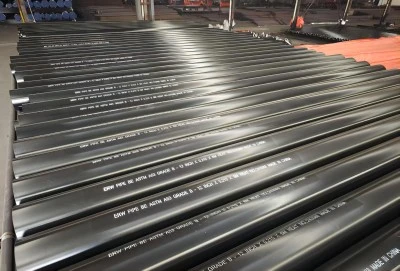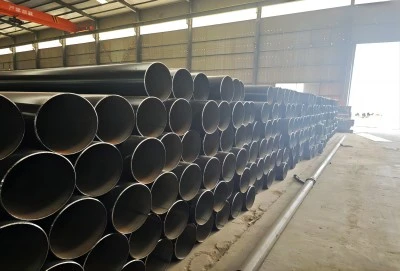When working with ASTM A53 Gr B pipes, proper end treatment is crucial for ensuring optimal performance, safety, and longevity of your piping system. Whether you're involved in industrial applications, construction projects, or maintenance work, understanding how to correctly prepare and finish pipe ends can make a significant difference in the overall quality of your installation. In this comprehensive guide, we'll explore the various methods and techniques for treating the ends of ASTM A53 Gr B pipes, why it's important, and how to choose the right approach for your specific needs.
|
|
|
Methods for proper pipe end preparation in ASTM A53 Gr B pipes
When it comes to preparing the ends of ASTM A53 Gr B pipes, several methods are commonly employed, each suited to different applications and joining techniques. Let's explore these methods in detail:
1. Beveling
Beveling is a popular method for preparing pipe ends, especially when welding is the chosen joining technique. This process involves creating a sloped edge on the pipe end, typically at a 30 to 37.5-degree angle. Beveling serves several purposes:
- It provides a clean, uniform surface for welding
- It helps ensure proper weld penetration
- It reduces the risk of weld defects
- It facilitates easier alignment of pipes during assembly
Beveling can be achieved through various means, including machining, grinding, or using specialized beveling tools. The choice of method often depends on the pipe size, wall thickness, and available equipment.
2. Threading
Threading is another common end treatment for ASTM A53 Gr B pipes, particularly in applications where frequent disassembly may be required or where welding is not feasible. The process involves cutting helical grooves into the pipe end to create a screw-like pattern. Threaded connections offer several advantages:
- They allow for easy assembly and disassembly
- They provide a secure, leak-tight connection when properly installed
- They're suitable for both temporary and permanent installations
Threading can be performed using manual die sets for smaller pipes or automated threading machines for larger diameters and higher volume production.
3. Square cutting
Square cutting is a straightforward method that involves cutting the pipe end at a 90-degree angle to its axis. This method is often used when:
- Pipes need to be joined using flanges or mechanical couplings
- A clean, flat surface is required for butting pipes together
- Preparing pipes for further end treatments like beveling or threading
Square cutting can be achieved using various tools, including pipe cutters, abrasive wheels, or plasma cutting equipment, depending on the pipe size and material thickness.
4. Swaging
Swaging is a process that involves expanding or reducing the diameter of the pipe end. This method is useful in certain applications where pipes of different diameters need to be joined without using additional fittings. Swaging can be done to:
- Create a bell end for socket welding
- Reduce the pipe end diameter for insertion into fittings
- Facilitate the joining of pipes with slight size differences
Swaging requires specialized equipment and is typically performed in a workshop setting rather than on-site.
Why proper end treatment is critical for ASTM A53 Gr B pipes
The importance of proper end treatment for ASTM A53 Gr B pipes cannot be overstated. Here are some key reasons why paying attention to pipe end preparation is crucial:
1. Ensuring structural integrity
Properly treated pipe ends contribute significantly to the overall structural integrity of the piping system. Whether you're using welded, threaded, or mechanical connections, a well-prepared pipe end helps ensure that the joint can withstand the intended pressures, temperatures, and external forces without failure.
2. Preventing leaks
One of the primary functions of any piping system is to contain and transport fluids or gases without leakage. Proper end treatment plays a vital role in creating leak-tight connections. For example:
- A correctly beveled pipe end allows for full weld penetration, reducing the risk of weld defects that could lead to leaks
- Accurately threaded pipe ends ensure a tight seal when coupled with appropriate fittings
- Square-cut ends provide a flat surface for flange connections, minimizing the potential for gaps and leaks
3. Enhancing safety
Safety is paramount in any industrial or construction setting. Properly treated pipe ends contribute to overall system safety by:
- Reducing the risk of joint failure under pressure
- Minimizing the potential for leaks of hazardous materials
- Ensuring consistent and reliable performance of the piping system
4. Improving efficiency
Well-prepared pipe ends can significantly improve the efficiency of both installation and operation:
- They facilitate easier and faster assembly, reducing installation time and labor costs
- They help maintain optimal flow characteristics within the piping system
- They minimize the need for rework or repairs due to poorly fitted connections
5. Extending system lifespan
Proper end treatment contributes to the longevity of your piping system by:
- Reducing stress concentrations at joints
- Minimizing the potential for corrosion or erosion at connection points
- Ensuring consistent performance over time
Common techniques for threading and beveling ASTM A53 Gr B pipe ends
Now that we understand the importance of proper end treatment, let's delve into some common techniques for threading and beveling ASTM A53 Gr B pipes.
Threading techniques
1. Manual threading: This method uses a die set and is suitable for smaller diameter pipes or low-volume production. The process involves:
- Securing the pipe in a vise
- Applying cutting oil to the pipe end
- Using a ratcheting die stock to cut the threads
- Periodically reversing the die to clear chips
- Checking thread quality with a thread gauge
2. Power threading: For larger pipes or higher volume production, power threading machines are more efficient. These machines can be portable or stationary and offer benefits such as:
- Faster threading speed
- More consistent thread quality
- Ability to handle larger pipe diameters
- Reduced operator fatigue
3. CNC threading: Computer Numerical Control (CNC) threading machines offer the highest precision and consistency, especially for complex threading requirements. They're ideal for high-volume production and can provide:
- Extremely accurate thread profiles
- Ability to create custom thread designs
- High repeatability
- Minimal operator intervention
Beveling techniques
1. Manual beveling: For small-scale projects or field work, manual beveling tools can be effective. These include:
- Handheld beveling machines
- Angle grinders with beveling attachments
- File and guide systems for precise angle control
2. Stationary beveling machines: These are ideal for workshop environments and offer benefits such as:
- Higher production rates
- More consistent bevel angles
- Ability to handle a wide range of pipe sizes
- Options for both internal and external beveling
3. Automated beveling systems: For large-scale projects or production environments, automated beveling systems provide:
- High-speed beveling capabilities
- Precise control over bevel angle and land thickness
- Integration with pipe cutting systems for streamlined production
- Ability to handle complex bevel profiles
4. Plasma beveling: This technique uses a plasma torch to create bevels and offers advantages such as:
- Fast beveling speed
- Ability to bevel thick-walled pipes
- Clean, precise cuts with minimal heat-affected zone
- Suitability for both straight and contoured bevels
Choosing the right technique
When selecting a threading or beveling technique for your ASTM A53 Gr B pipes, consider factors such as:
- Pipe size and wall thickness
- Production volume
- Required precision and consistency
- Available equipment and expertise
- On-site vs. workshop preparation
- Project budget and timeline
By carefully evaluating these factors, you can choose the most appropriate end treatment method for your specific application, ensuring optimal performance and longevity of your piping system.
Contact Longma Group
Proper end treatment of ASTM A53 Gr B pipes is a critical aspect of any piping project. By understanding the various methods available and their applications, you can ensure that your pipe ends are prepared correctly for their intended use. Whether you opt for beveling, threading, square cutting, or swaging, the key is to match the end treatment to your specific requirements and to execute the process with precision and care.
Remember that investing time and resources in proper pipe end preparation pays dividends in terms of system performance, safety, and longevity. If you're unsure about the best approach for your project, don't hesitate to consult with experts or reach out to reputable suppliers who can provide guidance and support.
For more information on ASTM A53 Gr B pipes and expert advice on pipe end treatment, feel free to contact us at info@longma-group.com. Our team of specialists is ready to assist you in selecting the right pipes and end treatment methods for your specific needs.














